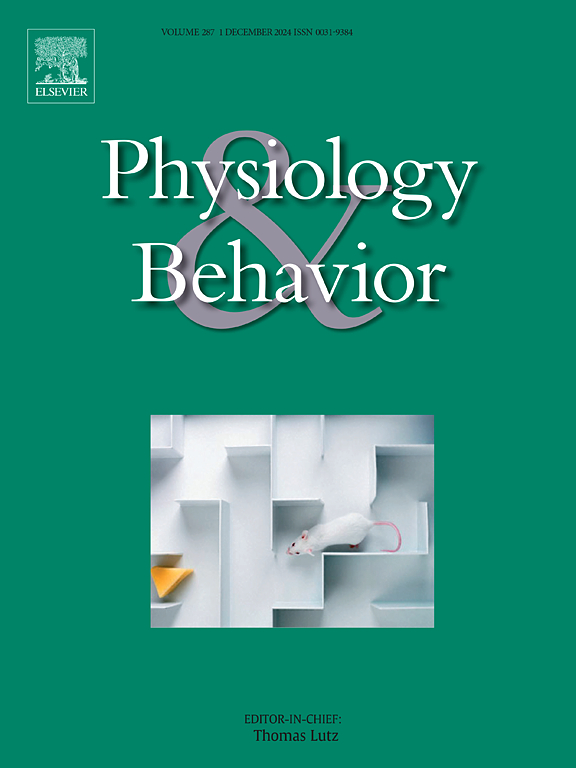Dietary protein restriction in rats leads to a rapid within-session preference for protein
IF 2.4
3区 医学
Q2 BEHAVIORAL SCIENCES
引用次数: 0
Abstract
Evolution has provided species with adaptive behavioural mechanisms that guarantee tight dietary protein regulation. However, an unsolved question is whether the well-established preference for protein-containing food manifested during states of protein restriction is innate or learned. Here, we tackled this problem by maintaining male rats on either a low-protein diet (4 % protein, protein-restricted) or a control diet (22 % protein, non-restricted) for 9–12 days, and then offered them two novel foods, a protein-containing solution (4 % casein) and a carbohydrate-containing solution (4 % maltodextrin) during a daily 60-minute free-choice test, repeated for 5 consecutive days. We assessed both the total and cumulative intake of each solution throughout each test, as well as the microstructure of licking behaviour as an index of the solutions’ palatability. In a second experiment, we exposed a different cohort of rats, before any behavioural test, to the same protein source (i.e., casein) that they would encounter during the free-choice tests, to assess whether familiarity with casein would drive subsequent casein intake even in non-restricted rats. We found that dietary protein restriction leads to a rapid preference (within 5 min of first exposure) for a casein-rich solution, and this preference is persistent over subsequent exposures. Increased palatability of protein during initial exposure correlated with protein preference in the restricted rats. Moreover, familiarity with casein did not lead to protein preference in non-restricted rats. This study demonstrates that, when in need of protein, protein preference is a rapid adaptation that requires minimal experience of protein.
饮食蛋白质限制导致大鼠对蛋白质的快速偏好
进化为物种提供了适应性行为机制,保证严格的饮食蛋白质调节。然而,一个尚未解决的问题是,在蛋白质限制状态下对含蛋白质食物的既定偏好是天生的还是后天习得的。在这里,我们通过让雄性大鼠保持低蛋白饮食(4%蛋白质,蛋白质限制)或对照饮食(22%蛋白质,非限制)9-12天来解决这个问题,然后在每天60分钟的自由选择测试中给它们两种新的食物,一种含蛋白质的溶液(4%酪蛋白)和一种含碳水化合物的溶液(4%麦芽糊精),连续重复5天。我们评估了每次测试中每种溶液的总摄入量和累积摄入量,以及舔舐行为的微观结构作为溶液适口性的指标。在第二个实验中,我们在任何行为测试之前,将另一组大鼠暴露在它们在自由选择测试中遇到的相同蛋白质来源(即酪蛋白)中,以评估对酪蛋白的熟悉是否会推动随后的酪蛋白摄入,即使在非限制大鼠中也是如此。我们发现,饮食蛋白质限制导致对富含酪蛋白的溶液的快速偏好(在第一次暴露的5分钟内),并且这种偏好在随后的暴露中持续存在。在初始暴露期间,蛋白质的适口性增加与限制大鼠的蛋白质偏好相关。此外,熟悉酪蛋白并不会导致非受限大鼠对蛋白质的偏好。该研究表明,当需要蛋白质时,蛋白质偏好是一种快速适应,需要最少的蛋白质经验。
本文章由计算机程序翻译,如有差异,请以英文原文为准。
求助全文
约1分钟内获得全文
求助全文
来源期刊

Physiology & Behavior
医学-行为科学
CiteScore
5.70
自引率
3.40%
发文量
274
审稿时长
47 days
期刊介绍:
Physiology & Behavior is aimed at the causal physiological mechanisms of behavior and its modulation by environmental factors. The journal invites original reports in the broad area of behavioral and cognitive neuroscience, in which at least one variable is physiological and the primary emphasis and theoretical context are behavioral. The range of subjects includes behavioral neuroendocrinology, psychoneuroimmunology, learning and memory, ingestion, social behavior, and studies related to the mechanisms of psychopathology. Contemporary reviews and theoretical articles are welcomed and the Editors invite such proposals from interested authors.
 求助内容:
求助内容: 应助结果提醒方式:
应助结果提醒方式:


